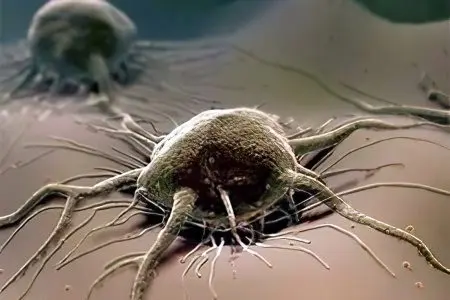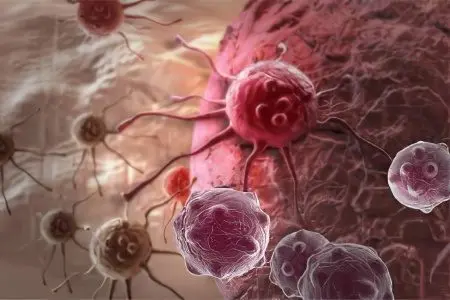Contents

A malignant tumor is an extremely life-threatening formation for any organism, which consists of malignant cells. The process of tumor development is accompanied by uncontrolled cell division, which are able to penetrate into neighboring tissues and send metastases to other organs located far away.
A malignant tumor is characterized by the following three features:
The tumor produces atypical cells, that is, those cells that differ from the tissues or organs from which they originated;
The tumor is characterized by cellular polymorphism, it will contain young cells that have a heterogeneous structure;
The tumor is characterized by autonomous growth, that is, its division is not able to be controlled by the body on its own.
Currently, the study of malignant tumors is carried out by such a branch of medicine as oncology. In foreign countries, this science is called carcinology.
According to statistics, malignant tumors very often cause death of people, ranking second in the world among all causes of death in the population. Only cardiovascular diseases are ahead of this pathology. It is estimated that every year 6 million people are exposed to cancer and 5 million of these people die each year. Men get sick 1,5 times more often than women. Depending on the sex, the location of the malignant tumor often also differs. Thus, in the male population, the lungs, prostate, stomach, rectum and large intestine are considered the most vulnerable organs. Women are more prone to tumors of the breast, uterus, stomach, skin, intestines (rectum and colon).
Reasons for the formation of a malignant tumor
Modern oncologists believe that the causes of the formation of a malignant tumor are multiple and it is impossible to identify any one factor leading to the formation of a pathological formation. Research, the results of which were published in the journal Nature, indicate that most often the development of a malignant tumor is influenced by the external environment, rather than heredity. More than 30 cell mutations leading to tumor development have been carefully evaluated and analyzed. As a result, the results showed that no more than 30% of these mutations occurred due to internal factors, and about 70-90% directly depended on the impact of harmful factors of the external environment. Among them: drinking alcohol, smoking, the negative impact on the body of ultraviolet and ionizing radiation, some viruses.
So, the modern oncological polyetiological theory identifies the following reasons for the development of malignant tumors:
Impact on the body of chemical carcinogens. Moreover, this effect is both locally and on the body as a whole. For example, chimney sweeps develop swelling of the scrotum, smokers develop lung tumors, people who work with asbestos develop swelling of the pleura, etc.
Exposure to physical carcinogens. Physical carcinogens include two types of radiation: ionizing radiation (X-rays, gamma rays, atomic particles), as well as exposure to ultraviolet rays, which provoke the development of skin carcinoma.
Genetic causes causing the development of malignant tumors. The fact that a small proportion of tumors appear in humans as a result of a genetic predisposition should not be completely rejected. Thus, a breast tumor in girls whose mothers had a similar disease is three times more common than in the general population. The same applies to tumors of the colon, tumors of the endocrine gland. At this point in time, a genetic connection with 50 types of tumors has been proven and tracked.
Dependence of the development of malignant tumors on the geographical area of human residence. So far, this phenomenon has not been scientifically explained, but it has been established that geographical factors have a certain influence on the development of oncology in the population living in the same territory. Scientists believe that influence is exerted by such factors as: diet, climate, environmental conditions, etc.
Influence of oncogenic viruses. Infectious factors that can provoke the development of a malignant tumor should not be excluded. It has been proven that hepatitis B can provoke a tumor of the liver, the herpes virus of the second type leads to tumors of the cervix.
However, scientists point out that one of these factors is not enough for a person to develop a malignant tumor. A combination of several causes is necessary, as well as disturbances in the functioning of the human immune system.
In addition to the polyetiological theory, indicating the causes of the development of malignant tumors, there are other theories of their origin, including:
The immunological concept suggests that even the slightest malfunction of the immune system can lead to the formation of a tumor. Adherents of this theory believe that if the immune system has not destroyed at least one mutated cell, then a tumor can develop from it.
The virus theory has existed since 1946 and indicates that viruses that enter them lead to the transformation of healthy cells into tumor cells. However, only a few viruses have been shown to be pathogenic to date.
The germline concept indicates that tumors develop from dormant cells that remain in the germ. Under the influence of a number of factors, they begin to grow and develop. However, it has been proven that this theory is applicable only for dysembryonic tumors.
The concept of irritation, which was popular in the 19th century, states that the tumor forms in those parts of the body that are most exposed to trauma.
Another theory is that the tumor is the result of regenerative processes that occur in order to eliminate the negative effects of carcinogens. This concept is called regeneration-mutation.
However, none of the above theories is able to fully explain the causes of all malignant tumors. Therefore, it is the polyetiological concept that remains the most popular.
Symptoms of a malignant tumor

If we consider the symptoms of a malignant tumor, then its specific manifestations will depend on where it is located and what tissues are involved in the pathological process. A characteristic feature of all malignant oncological formations is a progressive increase in symptoms. Oncologists have identified common symptoms for all tumors of a malignant nature:
Syndrome of small signs. This syndrome was first described by A. I. Savitsky, who in 1947 characterized a malignant tumor of the stomach. Then these symptoms were supplemented and generalized. So, the early manifestations of oncology are intoxication of the body and its depletion. Although it is possible that these signs of a malignant tumor may occur in the later period of the disease.
The patient begins to arrange faster, unmotivated weakness and fatigue develop. At the same time, appetite suffers. Lack of desire to consume food leads to weight loss. A tumor of the stomach is characterized by an aversion to meat. Anemia progresses, the level of ESR in the blood increases.
Another symptom that should alert patients is an increase in body temperature, which cannot be explained.
Plus-tissue syndrome. This syndrome characterizes the appearance of new tissue in the area where it should not be. That is, a tumor appears in the body, which is not characteristic of it. Often it can be felt during a standard examination. In some cases, even deep tumors can be palpated, especially if they are located in the abdominal cavity or in the retroperitoneal space. Help in their detection and other diagnostic techniques.
Syndrome of atypical discharge. Always malignant tumors lead to the appearance of secretions that are not characteristic of a healthy body. It can be bleeding when the tumor damages the blood vessels. Their localization depends on where exactly it is located. It is not excluded gastric and uterine bleeding, expectoration of blood, the appearance of blood in the urine or feces, etc.
In addition, the body reacts to the presence of a tumor by inflammation of its surrounding tissues. This will be expressed in the appearance of mucous or purulent discharge. Naturally, the site of inflammation depends on where the tumor is located.
Syndrome of dysfunctional organ disorder
The disorder of the organs directly depends on the location of the tumor:
Damage to the intestine provokes its obstruction.
Damage to the stomach leads to a variety of dyspeptic disorders: belching, vomiting, heartburn, etc.
Damage to the esophagus makes it difficult for food to pass through it, leading to a violation of swallowing.
Brain damage provokes nausea, headaches, mental disorders.
The defeat of the mammary gland leads to retraction of the nipple, pain, swollen lymph nodes.
The defeat of the uterus leads to a violation of the menstrual cycle, the impossibility of conception, etc.
The defeat of the ovaries provokes a hormonal imbalance in the body.
Kidney damage provokes problems with urination, hypercalcemia, anemia, edema, etc.
Occurrence of metastases
Cells that separate from the malignant tumor that forms them enter the neighboring organs and tissues in various ways. Settling there, they begin the process of their own division, producing new cells and forming daughter tumors. Most often, metastases are similar in structure to the primary tumor, but in rare cases they can be more aggressive.
Metastases can spread along the following routes: lymphogenous (prevails), hematogenous, implantation, cerebrospinal fluid, spread through interstitial crevices. In some cases, a mixed path of spread of metastases is observed. It has been established that different tumors are characterized by different ways and frequency of metastasis. For example, a tumor of the larynx rarely metastasizes, but a lung tumor most often has already spread throughout the body when it was first detected.
Types of malignant tumor

There are the following types of malignant tumors: carcinoma or cancer, which originate from epithelial cells and sarcoma, which develops from connective tissue and its subspecies. Therefore, to designate malignant tumors, the suffix “-carcinoma” or “-sarcoma” is used, for example, osteosarcoma, angiosarcoma, etc.
So, the types of malignant tumor:
Carcinoma (base – epithelial cells).
Melanoma (based on melanocytes).
Sarcoma (base – connective tissue).
Leukemia (based on transformed bone marrow cells).
Lymphoma (base – lymphatic tissue).
Teratoma (base – embryonic cells).
Glioma (based on glial cells).
Choriocarcinoma (base – placental tissue).
Stages of development of malignant tumors
Domestic oncologists work with a classification that includes four stages in the development of malignant tumors.
They look like this:
The first stage is characterized by a clear localization of the formation, which is located in a limited area and does not grow into the organ. At this stage, the tumor does not metastasize.
The tumor of the second stage of development is large, but does not extend beyond the organ. Metastases can be, but they are determined only in nearby lymph nodes.
At the third stage of tumor development, it is large, decay processes are launched. Sprouting into the wall of the organ is recorded. Launched multiple metastases in nearby lymph nodes.
At the fourth stage of tumor development, its germination in adjacent tissues is observed. This stage includes any formations that give distant metastases.
The patient is exposed to the stage once, and it remains with him until the end of his life. The stage is not changed, even if there is no recurrence of the disease. The stages of tumor development should not be confused with the clinical groups that are assigned to patients. There are also four of them, but they can vary depending on the condition of the person. These groups have been created for the convenience of registering people with cancer.
Diagnosis of malignant tumors

Diagnosis of malignant tumors is built on the examination of a patient who makes certain complaints. If there is a suspicion of an oncological process, the patient is referred for a consultation with an oncologist. He uses the following methods in his work:
Laboratory diagnostics. It includes a blood test, the determination of enzymes and the conduct of special tests.
Immunological diagnostics. Immunological diagnostics includes the determination of monoclonal bodies that produce hybridomas. In addition, immunological diagnostics is carried out with oncomarkers, the number of which increases sharply in the presence of a malignant tumor in the body. For certain organs, their tumor markers are specific, for example, alpha-fetoprotein tumor marker is used for liver and testicular tumors, carcinoembryonic antigen tumor marker is used to determine a breast tumor, etc.
In the arsenal of doctors there are also markers that allow you to determine what tissue metastases consist of if the maternal tumor remains undetected.
Instrumental diagnostic techniques. Instrumental methods of examination will depend on what kind of tumor is suspected in the patient.
These can be diagnostic procedures such as:
Colonoscopy, FGDS (examination with a probe, stomach + 12 duodenal ulcer), bronchoscopy – endoscopic examination methods.
Ultrasound.
CT
Contrast or standard x-ray examination.
Radionuclide diagnostics.
MRI.
Thermography.
Verification of oncological diagnosis. To confirm a malignant tumor, a cytological examination is performed, which allows you to clarify the diagnosis in 92% of cases. It includes puncture sampling, biopsy, smear-imprint sampling and scarification.
Histological examination allows you to determine the likelihood of a malignant tumor in 99,8% of cases. To conduct a histological examination, a biopsy is performed, that is, taking a tissue sample from a patient for the purpose of its subsequent study. The tissue can be excised, taken by the puncture method, or total removal of the tumor with its subsequent study is possible.
A biopsy is not performed for melanoblastoma, since any damage to this type of tumor can provoke its accelerated growth.
Carrying out differential diagnosis. A malignant tumor differs from a benign formation in its rapid growth rate, bumpy surface, and increased density. Most often, such tumors are immobile, do not have clear boundaries and are associated with the skin. In this case, the lymph nodes are enlarged, but remain painless.
Treatment of malignant tumors

The treatment of malignant tumors is exclusively surgical. Hormone therapy is possible, but the indication for this is the presence of hormone-dependent tumors.
In addition, the treatment of malignant tumors can be carried out by means of chemotherapy, radiation therapy and immunotherapy. All these methods can be applied either separately or in combination with each other.
So, the options for operations in the presence of a malignant tumor are as follows:
radical therapy. The tumor is excised along with the organ that it struck. In addition, adjacent lymph nodes and cells are removed. Operations are not performed when a tumor of the fourth stage is detected.
Palliative care. If the operation is impossible to perform, then the patient’s life is prolonged and its quality is improved with the help of palliative treatment. The tumor is removed, but the lymph nodes are left. They are affected by other methods, for example, radiation therapy. This helps to cope with the disease for a while.
Symptomatic surgery. This therapy is aimed at eliminating the main symptom, which poses a direct threat to the life of the patient, for example, intestinal obstruction. The tumor is not removed from the body.
Regarding radiotherapy, then the source of radiation can be x-rays, gamma rays, alpha and beta rays. Lymphosarcoma, cancer of the skin, larynx, bronchi, esophagus, and cervix respond well to radiation therapy. The dose and mode of irradiation for each patient is selected individually. It is possible to carry out intracavitary, interstitial and external irradiation. You should know that radiation therapy cannot pass without a trace for the human body. It is almost always associated with a number of complications. Doctors are required to advise each patient about this.
Chemotherapy is reduced to a drug effect on the tumor. This can be achieved through the use of various drugs.
It is prescribed for the following indications:
In combination with other treatments;
Before the operation in order to increase the effectiveness of the upcoming intervention;
As a palliative technique.
To perform chemotherapy, drugs such as: cytostatics, antitumor antibacterial drugs, antimetabolites, hormonal drugs (they are selected taking into account the location of the tumor), platinum drugs, and other drugs are used.
Immunotherapy also includes several varieties, including: non-specific immunotherapy (the effect will not always be achieved), topical application of vaccines, the introduction of cells with cytostatic and cytotoxic effects, the introduction of proteins (hematopoietic growth factors), specific immunotherapy (the introduction of anti-cancer vaccines and sera ).
Answers to popular questions
Is the tumor visible on ultrasound, X-ray and fluorography? All these examination methods are able to “see” the presence of a particular formation, but it is impossible to say that this is a malignant tumor according to only ultrasound, X-ray examination or fluorography. Additional diagnostic techniques will be required.
Can a benign tumor become malignant? Yes, it can, and this process occurs quite often and is called malignancy.
Does a cancerous tumor hurt when pressed? Pain when pressing on a cancerous tumor appears only in the later stages of its development.
Is there a bone marrow tumor? There is no such thing as a bone marrow tumor, but atypical cells can affect the bone marrow. In this case, doctors talk about cancer of the myeloid (hematopoietic) tissue.









